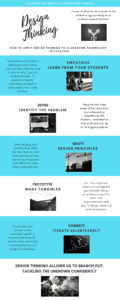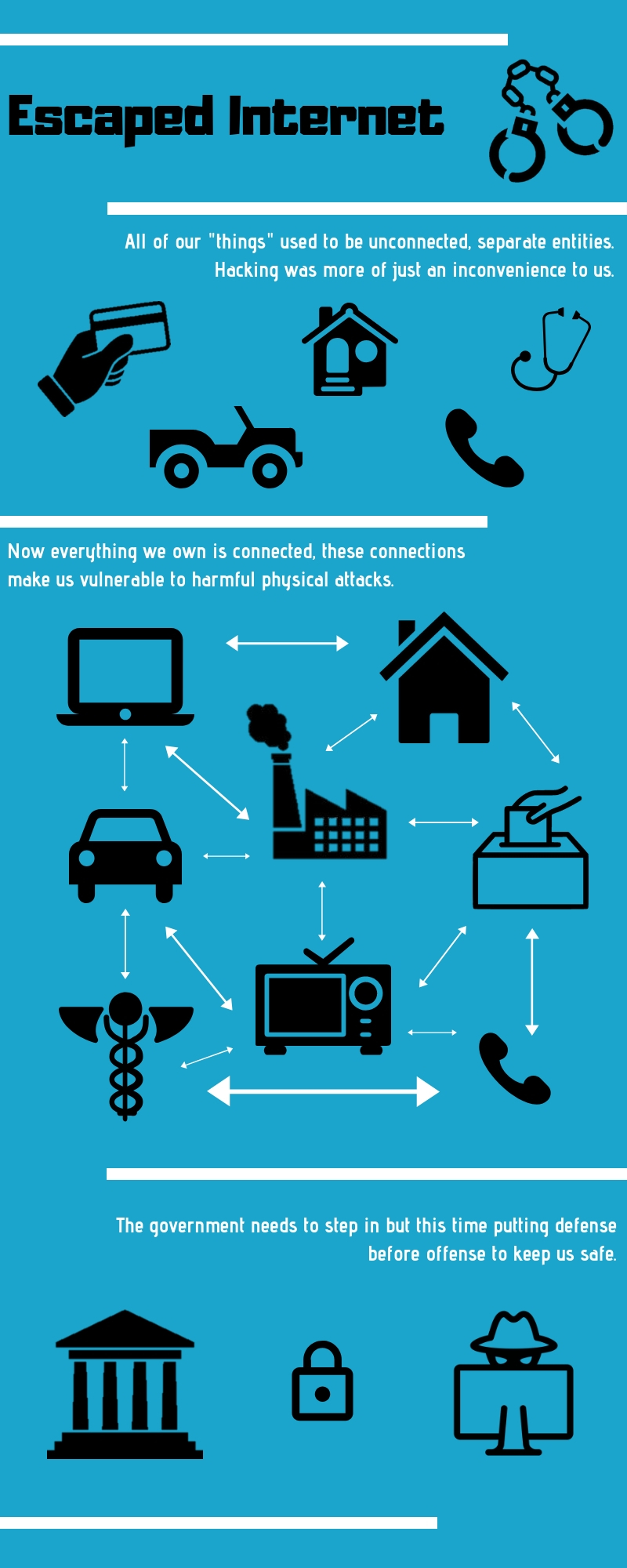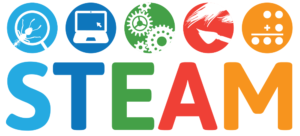After working through eCampus Ontario’s Technologist Module in class and further on my own time, I choose to visually represent my ideas in the form of an Infographic. I consider myself to be more creative rather than artistic so I enjoy using the templates provided by Canva. These templates allow me just enough artistic freedom to make my own unique artifact but not enough that I am liable to screw anything up. I liked the idea of posing a question to readers when they look at my Infographic and then going on to explain the possible answers to that question while still allowing the readers to formulate their own opinions. As educators many of us may have different comfort levels and attitudes when it comes to technology integration versus traditional tried and practiced teacher centered strategies. I, however, am very open to the integration of technology in the classroom and think I framed my Infographic in a way that got that message across.
using the templates provided by Canva. These templates allow me just enough artistic freedom to make my own unique artifact but not enough that I am liable to screw anything up. I liked the idea of posing a question to readers when they look at my Infographic and then going on to explain the possible answers to that question while still allowing the readers to formulate their own opinions. As educators many of us may have different comfort levels and attitudes when it comes to technology integration versus traditional tried and practiced teacher centered strategies. I, however, am very open to the integration of technology in the classroom and think I framed my Infographic in a way that got that message across.
The Technologist Module did an excellent job of outlining steps to use when contemplating technology integration into the classroom. The creators of the module essentially asked, “Are you stuck between deciding if using innovative technology or evidence based is best?” then went on to provide a process for determining if technology integration is the best option for you. The creators of this module suggested using Design Thinking, which is a solution based approach to solving small problems on route to solving the much bigger more complex problems. The five steps to Design Thinking are empathize, define, ideate, prototype and connect. During the first step teachers need to take the time to learn from their students to determine what is trul y needed. Learning about what excites students, what they love to do and what they’re afraid of will help determine what the problem really is and is the first step to the solution. During the define stage teachers need to use their intuition to make sense of the information they’ve learned through conversations with their students. In the next stage it’s important to start building and forming ideas of what the ideal features and characteristics of how technology integration may solve your problem. This is also the stage where you may determine that technology integration isn’t the answer or that you may need to dig deeper into framing the problem. In the prototype stage asking “how might we?” questions will help to bridge the gap between design principles and specific ideas, using play and experimentation while designing, sharing and refining prototypes will help with this process. The final stage of Design Thinking is to connect. This is the time to connect to the curriculum, speak to teachers and students and remember to never stop trying to improve when it comes to integrating technology into your classroom.
y needed. Learning about what excites students, what they love to do and what they’re afraid of will help determine what the problem really is and is the first step to the solution. During the define stage teachers need to use their intuition to make sense of the information they’ve learned through conversations with their students. In the next stage it’s important to start building and forming ideas of what the ideal features and characteristics of how technology integration may solve your problem. This is also the stage where you may determine that technology integration isn’t the answer or that you may need to dig deeper into framing the problem. In the prototype stage asking “how might we?” questions will help to bridge the gap between design principles and specific ideas, using play and experimentation while designing, sharing and refining prototypes will help with this process. The final stage of Design Thinking is to connect. This is the time to connect to the curriculum, speak to teachers and students and remember to never stop trying to improve when it comes to integrating technology into your classroom.
During each of my practicum placements I’ve struggled with making the choice between whether it was appropriate to integrate technology into my lessons or if another approach would be best suited for those particular situations. Knowing about Design Thinking and the process proposed by the Technologist Module would have helped to make those decisions and not leave me second guessing myself. As a new teacher who is relatively new to bringing technology in the classroom often times my technology integration was doing nothing to elevate my lessons,  instead I was simply using technology as a tool substitution but not making any functional changes to the lesson. As someone who is going to be a physical education teacher I am always trying to think of ways to reach learners of all styles in the gym which at times can be even more difficult when in the classroom. When asked to complete a task such as hitting a baseball some students may need a different type of instruction to succeed than the conventional methods. Using Design Thinking I would have a conversation with my students and learn that they really enjoy watching video of professional athletes and that just being told how to do something isn’t the way they learn best. I would then come to the conclusion that my problem to solve may be how do I incorporate technology into my class to teach my students how to hit a baseball. Working through the next phases of the decision making process I would come to the conclusion that redefining my lesson using technology integration would help my students immensely. I could have my students watch video examples, practice the technique and then video tape the students hitting balls which would allow me to give feedback about their technique.
instead I was simply using technology as a tool substitution but not making any functional changes to the lesson. As someone who is going to be a physical education teacher I am always trying to think of ways to reach learners of all styles in the gym which at times can be even more difficult when in the classroom. When asked to complete a task such as hitting a baseball some students may need a different type of instruction to succeed than the conventional methods. Using Design Thinking I would have a conversation with my students and learn that they really enjoy watching video of professional athletes and that just being told how to do something isn’t the way they learn best. I would then come to the conclusion that my problem to solve may be how do I incorporate technology into my class to teach my students how to hit a baseball. Working through the next phases of the decision making process I would come to the conclusion that redefining my lesson using technology integration would help my students immensely. I could have my students watch video examples, practice the technique and then video tape the students hitting balls which would allow me to give feedback about their technique.
Hope you enjoy my Infographic! If the thumbnail below is too hard to read here’s a link to the PDF file. Multimedia Artifact (PDF)
Christine


 The internet used to just be about data, when our data was stolen and abused it was more of an unfortunate inconvenience but now the internet has access to things that can actually harm us and this presents a real risk to our well-being. Schneier explains the only way for companies to improve the security on their products is for the government to step in and force them to. Without an order from the government the only thing these companies are concerned with is making a profit off ill-informed consumers who are not even thinking about the security risks of purchasing a new refrigerator.
The internet used to just be about data, when our data was stolen and abused it was more of an unfortunate inconvenience but now the internet has access to things that can actually harm us and this presents a real risk to our well-being. Schneier explains the only way for companies to improve the security on their products is for the government to step in and force them to. Without an order from the government the only thing these companies are concerned with is making a profit off ill-informed consumers who are not even thinking about the security risks of purchasing a new refrigerator. educate students about the risks that come along with all the technology they are being exposed to. Does their home really need to be connected to their phones? With the thermostat, lights, TV and security system accessed through an app we are essentially inviting strangers into our homes because of convenience. Instead of remembering to turn off the lights we can just do it from the car on our morning commute. Educating students about what is available to them in terms of technology as well as the risks that go along with it will allow them to think critically about the risks they are opening themselves up to. Hopefully safety and security of citizens in the technical world will soon become the government’s first priority but until it is, as a future educator I will make sure to give my students the tools they need to protect themselves.
educate students about the risks that come along with all the technology they are being exposed to. Does their home really need to be connected to their phones? With the thermostat, lights, TV and security system accessed through an app we are essentially inviting strangers into our homes because of convenience. Instead of remembering to turn off the lights we can just do it from the car on our morning commute. Educating students about what is available to them in terms of technology as well as the risks that go along with it will allow them to think critically about the risks they are opening themselves up to. Hopefully safety and security of citizens in the technical world will soon become the government’s first priority but until it is, as a future educator I will make sure to give my students the tools they need to protect themselves.
 within the selected template. These learning apps and platforms invite students to follow the directions, get the right answer, turn it in, and get praise. Although many teachers will claim to be moving towards a more authentic way of educating children, either purposely or without knowing these websites and platforms used by teachers reflect the old way of teaching and learning, which views students as containers to be filled with the right answers by teachers. Unfortunately even when these platforms and websites are absent from classrooms they are still affecting student learning, instead we as educators need to help our students move away from users of shortcut/template platforms to makers, creators and critical thinkers.
within the selected template. These learning apps and platforms invite students to follow the directions, get the right answer, turn it in, and get praise. Although many teachers will claim to be moving towards a more authentic way of educating children, either purposely or without knowing these websites and platforms used by teachers reflect the old way of teaching and learning, which views students as containers to be filled with the right answers by teachers. Unfortunately even when these platforms and websites are absent from classrooms they are still affecting student learning, instead we as educators need to help our students move away from users of shortcut/template platforms to makers, creators and critical thinkers. dium for my response because after exploring a few of the other options I was a little intimidated by needing to create something digitally. Additionally, after reading the article which spoke about online platforms limiting creative freedom I felt as though this medium just made sense because it would allow me to get my genuine untouched thoughts across. If I were to use this medium again for a similar purpose I would spend more time brainstorming and planning my Sketchnote before getting started.
dium for my response because after exploring a few of the other options I was a little intimidated by needing to create something digitally. Additionally, after reading the article which spoke about online platforms limiting creative freedom I felt as though this medium just made sense because it would allow me to get my genuine untouched thoughts across. If I were to use this medium again for a similar purpose I would spend more time brainstorming and planning my Sketchnote before getting started. M is about incorporating the arts into math, science and technology but by using these shortcut/template websites and platforms we are limiting the range of creative freedom for students trying to create when using technology. Secondly, I think that we need to give students the tools to critically reflect on these platforms on their own. By teaching our students to think critically and analytically they can start finding these digital ghosts themselves and find alternative ways to create digitally that allow them to use all of their own authentic ideas.
M is about incorporating the arts into math, science and technology but by using these shortcut/template websites and platforms we are limiting the range of creative freedom for students trying to create when using technology. Secondly, I think that we need to give students the tools to critically reflect on these platforms on their own. By teaching our students to think critically and analytically they can start finding these digital ghosts themselves and find alternative ways to create digitally that allow them to use all of their own authentic ideas.